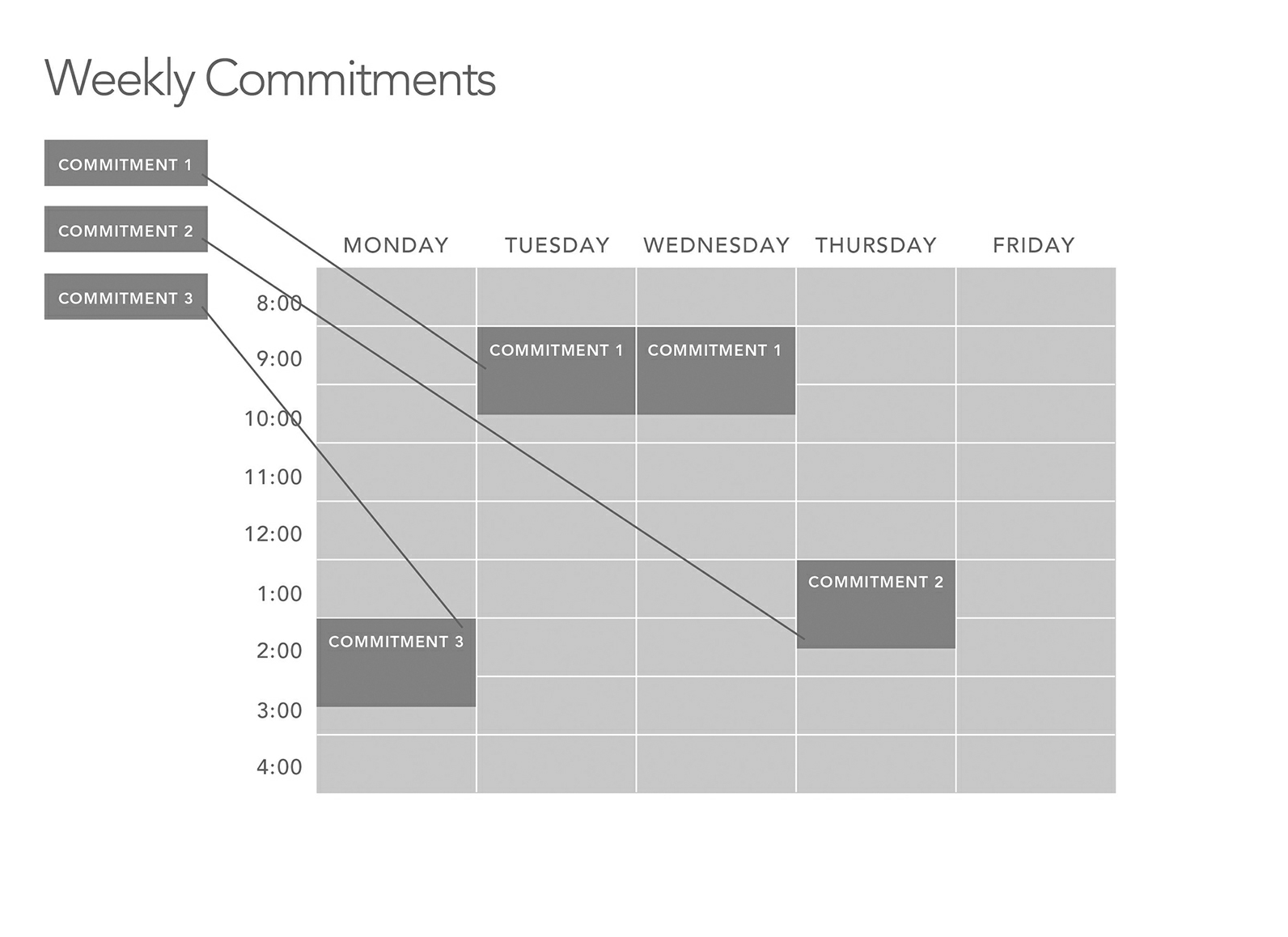The first pillar of management: Priority
Without consistency, there are no commitments. Without commitments, there's no work on priorities.

There are 3 pillars of strong management in a team:
- Priority: Choosing the right work
- Competence: Ability to do the work
- Motivation: Effectively doing the work
Priority is essential because no amount of high-quality work will matter if your team is doing the wrong work.
Finding levers in our goals
It was annual planning and OKR season, and we added a new terminology to our vocabulary: Levers.
Like many other startups, we had an OKR revenue goal: make X million dollars by EoY. We then broke it down by new sales, renewals, etc.
But now we were talking about levers: What were the biggest levers for increasing sales and renewals? Close rate? Pipeline creation? Implementation? Training? Hiring? Tooling?
Instead of a "spray and pray" strategy where we'd try to improve everything that could improve, we started nailing down the areas where concentrated effort would most impact our goals.
Our KRs were, therefore, not KRs about revenue but about levers: Hire for these roles, improve the close rate in this tier from X to Y, survey customers about implementation satisfaction and get a score of A, increase activation of existing customers by Z, etc.
Once you have clarity about the top-level goal to achieve, your team must work on the right things to maximize its achievement.
Clarify your team's priorities
In the timeless 7 Habits of Highly Effective People, Stephen Covey has a memorable "wrong jungle!" metaphor for his difference between management and leadership: Management is about doing the work, Leadership is about choosing the work.
Management is a bottom-line focus: How can I best accomplish certain things? Leadership deals with the top line: What are the things I want to accomplish? In the words of both Peter Drucker and Warren Bennis, “Management is doing things right; leadership is doing the right things.” Management is efficiency in climbing the ladder of success; leadership determines whether the ladder is leaning against the right wall.
You can quickly grasp the important difference between the two if you envision a group of producers cutting their way through the jungle with machetes. They’re the producers, the problem solvers. They’re cutting through the undergrowth, clearing it out.
The managers are behind them, sharpening their machetes, writing policy and procedure manuals, holding muscle development programs, bringing in improved technologies, and setting up working schedules and compensation programs for machete wielders.
The leader is the one who climbs the tallest tree, surveys the entire situation, and yells, “Wrong jungle!”
Covey, Stephen R.. The 7 Habits Of Highly Effective People: Revised and Updated: 30th Anniversary Edition (p. 115). Simon & Schuster UK. Kindle Edition.
No amount of effective tree-cutting is valuable to your goals if you're in the wrong jungle!
Covey quotes Peter Drucker because that's a message the management guru hammers in our heads in his 1966 classic The Effective Executive:
Effective executives concentrate on the few major areas where superior performance will produce outstanding results. They force themselves to set priorities and stay with their priority decisions. They know that they have no choice but to do first things first — and second things not at all. The alternative is to get nothing done.
Drucker, Peter F.. The Effective Executive (Harperbusiness Essentials) (p. 24). HarperCollins. Kindle Edition.
The "second things not at all" is the hardest part. Given their day-to-day demands, it doesn't matter what priorities you set if your team can't choose to focus on them.
So how do you empower your team to focus work on the priorities amidst the chaos of day-to-day?
Avoiding the whirlwind to work on team priorities
Your team and each of its team members are never just working on the team priorities: they are constantly balancing day-to-day demands, making internal decisions on how to spend time, getting interrupted by others, and misunderstanding what the priority is or means.
In Sean Covey's 4 Disciplines of Execution, he suggests a term for the day-to-day that engulfs our priorities: The Whirlwind.
The difference is easy and kinda funny:
- Strategic goals is work you act on
- Whirlwind is work that acts on you, i.e. most of your work
THE WHIRLWIND
The real enemy of execution is your day job! We call it the whirlwind. It’s the massive amount of energy that’s necessary just to keep your operation going on a day-to-day basis; and, ironically, it’s also the thing that makes it so hard to execute anything new. The whirlwind robs from you the focus required to move your team forward.
Leaders seldom differentiate between the whirlwind and strategic goals because both are necessary to the survival of the organization. However, they are clearly different, and more important, they compete relentlessly for time, resources, energy, and attention. We don’t have to tell you which will usually win this fight.
The whirlwind is urgent and it acts on you and everyone working for you every minute of every day. The goals you’ve set for moving forward are important, but when urgency and importance clash, urgency will win every time. Once you become aware of this struggle, you will see it playing out everywhere, in any team that is trying to execute anything new.
The 4 Disciplines of Execution: Achieving Your Wildly Important Goals (pp. 6-7). Free Press. Kindle Edition.
The way for your team to make progress on priorities is not by avoiding the whirlwind, which is impossible, but by consistently making time to work on priorities despite the whirlwind.

Unless you create a clear cadence of weekly commitments and accountability for progress on your priorities, your team will be carried away by the whirlwind and not choose the right work to do.
It's hard to prioritize work when there's no cadence of accountability for its progress.
Build a cadence of accountability
Ensuring you and your team consistently work on priorities despite the whirlwind is simple but not easy: You must create a cadence of accountability.
Cadence of accountability involves 2 things: Cadence and Accountability.
1) Cadence: You must do this every week. Daily is too often for any reasonable commitments you can make in the whirlwind, and commitments of several weeks get swept away by the whirlwind.
The most important thing about cadence is consistency. If you meet on Mondays, always meet on Mondays. Ensure everybody joins. If Monday is a holiday, reschedule for Tuesday. Never cancel.
Why is the cadence of accountability so important? Consider the experience of someone with whom we’ve worked. He and his teen-age daughter made an agreement that she would be allowed the use of the family car if she washed it every Saturday morning. He would meet with her each Saturday to make sure the car was clean.
They met on Saturday for several weeks and everything went well, but then he had to go out of town for two Saturdays in a row. When he returned, he found that the car had not been cleaned. He asked his daughter why she hadn’t taken care of her job. “Oh,” she replied. “Are we still doing that?”
The 4 Disciplines of Execution: Achieving Your Wildly Important Goals (pp. 13-14). Free Press. Kindle Edition.
Without consistency, there are no commitments. Without commitments, there's no work on priorities.
2) Accountability: The person making the commitment must be accountable. Accountability is a strong word sometimes used for "who's taking the blame?" but I prefer to think about accountability as "providing an account" – that's it.
Providing an account is merely reporting what happened. When someone is accountable for their commitments, they're responsible for providing an account of how their commitments went.
A cadence of accountability ensures a rhythm of "what happened?" accounts, which is crucial for ensuring your team chooses the right work week after week instead of working on other things.
Accountability is required for focused prioritization.
Prioritize with levers and a cadence of accountability
In summary, the first pillar of leadership is prioritization. There's no point in doing great work if it's the wrong work to do.
To start, you must find the levers: the few major areas where superior performance will lead to outstanding results.
Then, you must build a cadence of accountability, with weekly meetings where you report on your commitments to focus on priorities despite the whirlwind.
With effective prioritization, your team will have 1 out of 3 pillars built, the most essential of all: Working on the work that must be done.
